
Vlad Yudkin
02 May, 2024
Dental SEO: 12 Tips to Improve for Better Ranking
In 2024, SEO is essential for dentists who aim to expand their practice and continue attracting new patients. Developing a dental SEO strategy is crucial. Possessing knowledge and expertise in this area will help you grasp the significance of SEO and prepare you to effectively enhance your search engine rankings.
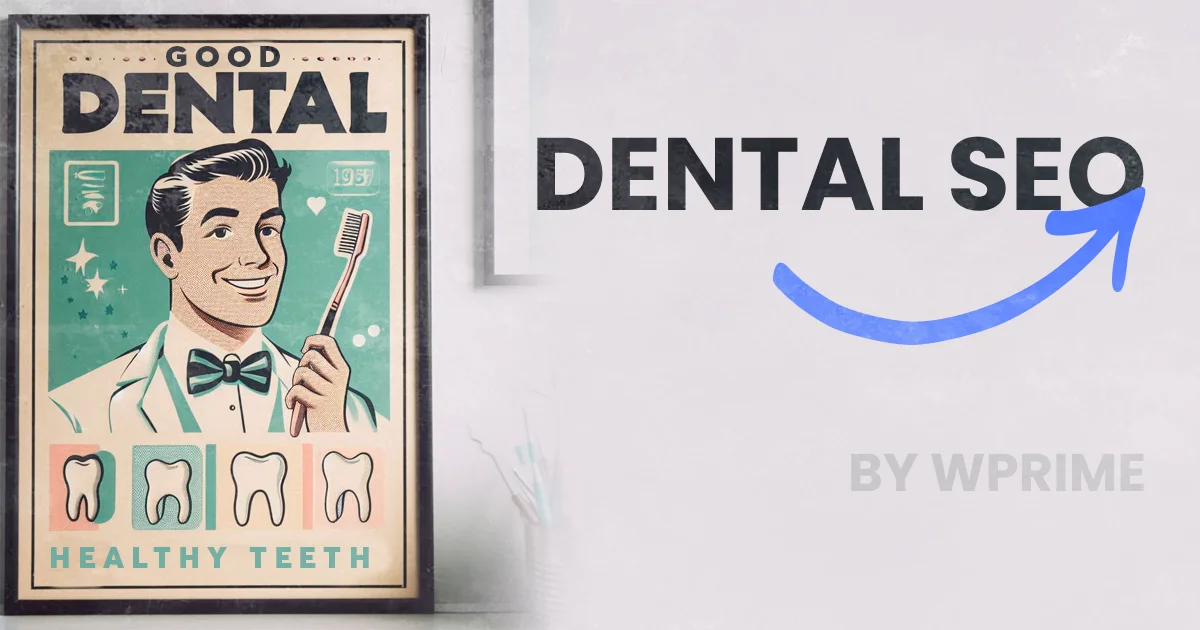
In this article, we will guide you through all the important aspects of SEO for dentists.
What is Dental SEO?
Dental SEO refers to the specialized techniques and strategies used to optimize a dentist’s online presence, specifically targeting search engine results to attract more patients. This process involves tailoring website content, structure, and dental keywords to appear prominently when potential patients search for dental-related services in search engines, ultimately aiming to increase the visibility and accessibility of the dental practice online.
If dental SEO is done correctly, you will be able to rank high in such results:
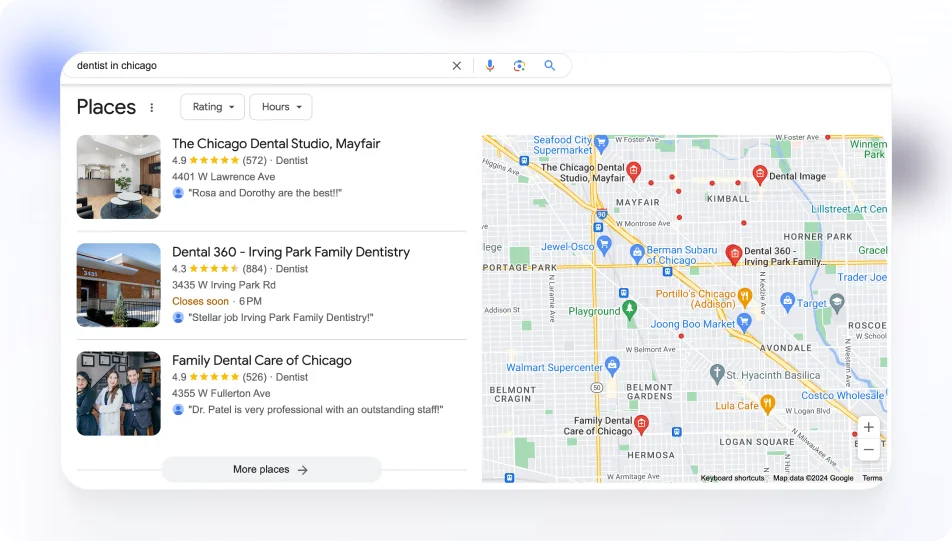
Important Benefits of Dental SEO Marketing
SEO marketing for dentists offers a range of benefits that can significantly enhance the visibility and reach of a dental practice. Here is why SEO is so important:
- Increased Online Visibility. Given that 75% of users never scroll past the first page of Google, SEO for dental websites can dramatically increase your practice’s chances of appearing on this coveted first page. This translates to higher visibility among potential patients who are actively searching for dental services.
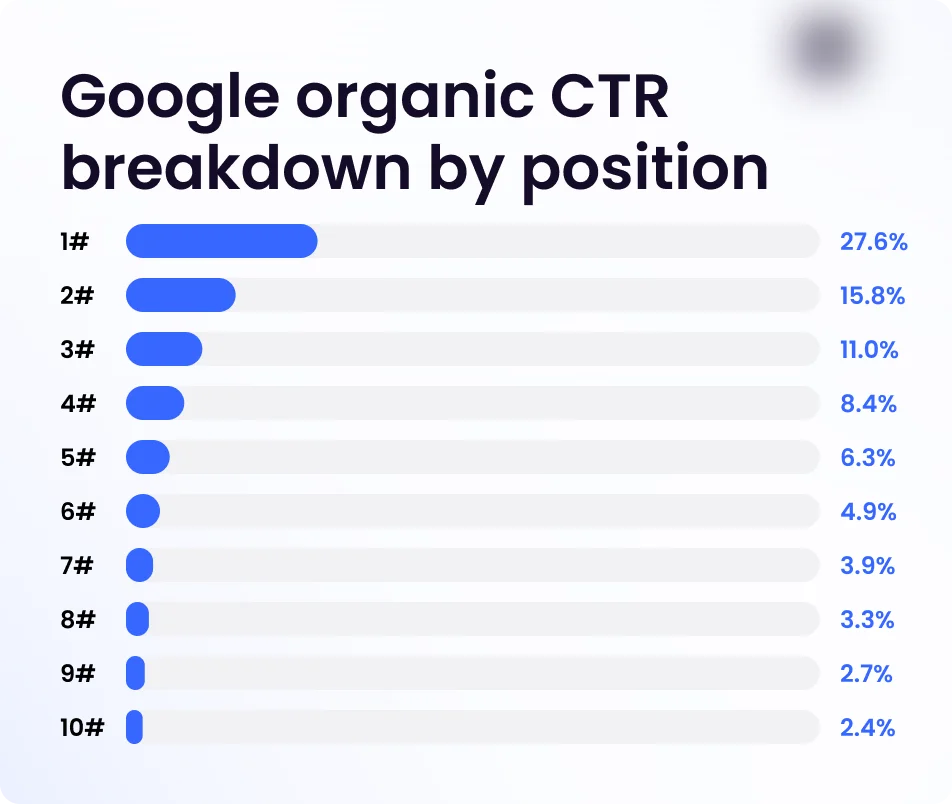
- Higher Trust and Credibility. Most people tend to skip paid advertisements (ads) and focus on organic search results. By optimizing your website for SEO, your practice appears as a top organic result, which can enhance its credibility and trustworthiness in the eyes of potential patients.
- Targeted Web Traffic. SEO helps you target specific keywords related to dental services. This strategy ensures that the traffic coming to your website is from individuals genuinely interested in dentist services, increasing the likelihood of converting visits into appointments.
- Cost-Effective Marketing. Unlike paid advertising campaigns that require ongoing funding to maintain visibility, SEO provides a more cost-effective solution. Once you achieve a high ranking, it requires relatively less expense to maintain, offering a better long-term return on investment.
- Competitive Edge. In a highly competitive field, appearing on the first page of Google can give you a significant edge over competitors who are not using effective and thoughtful SEO strategies. This can lead to more patient engagements and a stronger reputation in your local area.
- Enhanced User Experience. Involves optimizing elements of your website not just for search engines, but also for visitors. This can include improving site speed, navigation, and content quality, all of which contribute to a better user experience and potentially higher patient satisfaction and retention rates.
Also consider these statistics:
- Audience Scan research shows that 89% of patients who change dentists utilize Google for their online searches.
- 89% of searchers value an online review as highly as a personal referral.
- 64% of local clients primarily use search engines and directories to locate local businesses.
- Half of the searches on local mobile devices are for specific business information, such as addresses or phone numbers.
- 78% of local searches conducted on mobile devices lead to some form of direct interaction.
- Every month, there are more than 1.2 million Google searches for "dentist near me" across the U.S.
To make it easier to understand the use of dental SEO, let’s look through this example:
Imagine you determine that the average annual value of a patient is $750, and they typically remain with your practice for about 8 years. $750 x 8 years = $6,000. This means that each new patient is expected to bring in about $6,000 in lifetime revenue.
Now, suppose after implementing a thoughtful SEO strategy, your website starts attracting an average of 3 new patients each month. According to the previous calculation, these 3 patients represent approximately $18,000 in potential lifetime value every month. Over a year, that’s 36 new patients, equating to an additional $216,000 in future revenue attributable to your SEO efforts.
This clearly indicates that employing dentist SEO strategies can significantly boost your client base and income.
Dental SEO Marketing: 12 Ways to Improve Your Strategy
Starting SEO dental marketing can seem daunting. To help you navigate this process, we've compiled a collection of top tips to enhance your understanding of how it all works!
Dentists SEO primarily focuses on local SEO because most dental practices cater to patients within a specific geographic area. Patients typically search for dental services close to home, which makes local SEO crucial for attracting and retaining a patient base relevant to your location.
By optimizing for local search terms, ensuring accurate local listings, and engaging with local community content, dental practices can effectively position themselves at the top of search results in the areas they serve.
Further in our article we will provide advice specifically through the lens of local SEO so that the information we offer is highly pertinent and valuable for dentist search engine optimization.
Optimize Your Profile in Google My Business
Google My Business is a powerful tool that helps your business provide users with all the information they might need. It is a very important part of dental SEO. It ensures that essential details such as your location, hours of operation, contact information, and services are readily accessible, making it easier for potential customers to find and choose your business.
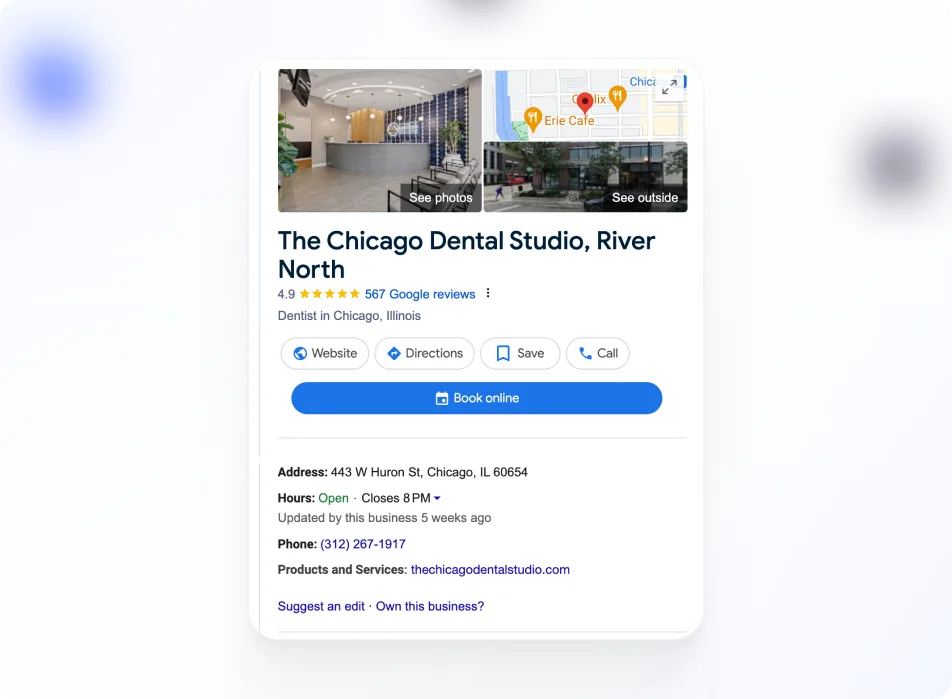
This is not just about filling in the basic information. Here are the key details you should provide:
- Business Name. Ensure that the name exactly matches the one you use on your signage and other branding materials.
- Input a precise, consistent address.
- Phone Number. Provide a local phone number that connects directly to your office. This ensures that potential patients can easily reach you.
- Business Category. Select the most accurate category, such as “Dentist” or “Dental Clinic”, to help Google better understand the nature of your business and show it in relevant searches.
- List all services you offer, such as teeth cleaning, whitening services, orthodontics, etc. Detailed service listings can improve how well your GMB profile matches with specific search queries.
- Business Hours. Update your operating hours accurately, including special hours for holidays or events, to inform patients when you are available.
- Website URL. Include a link to your professional website. This drives traffic to your site and provides additional information that might help convert searches into appointments.
- Write a compelling and informative description of your practice. Highlight unique services, your expertise, and what sets you apart from other dentists.
- Upload high-quality photos of your practice, including the interior, exterior, staff, and before-and-after images of work if possible. Visuals make your listing more appealing and can influence potential clients' decision-making process.
- Reviews and Responses. Encourage satisfied patients to leave positive reviews, and make sure to respond professionally to all reviews. Active engagement demonstrates customer service commitment and can influence new patients.
- Posts and Updates. Utilize the Posts feature to share updates, promotions, and news about your practice. Regular posts keep your profile active and engaging for potential clients.
Reviews are very valuable, because 98% of individuals look up online reviews for local businesses. To encourage client reviews, consider these streamlined strategies:
- Visual Reminders. Use posters and printable materials provided for free by Google's customized marketing kit to remind patients to leave reviews.
- In-Office Prompts. Have your receptionist encourage reviews during patient goodbyes, and consider setting up a review station with a tablet at the reception for immediate feedback.
- Email Review Requests. Send emails with a direct link to your Google reviews page post-appointment, assuming you have patient consent.
Technical SEO
Technical SEO is important for ensuring that your website functions efficiently and ranks well in search engine results. It focuses on optimizing the backend structure of your site so it's accessible and indexable by search engines, while also providing a seamless user experience. Regularly addressing and fixing technical SEO issues is essential for maintaining the health and performance of your website.
Common technical SEO issues that often need attention include:
- Site Speed. Slow loading times can frustrate users and negatively impact SEO.
- Mobile Responsiveness. With the increasing use of mobile devices for internet browsing, it's essential for SEO to ensure your website is mobile-friendly.
- HTTPS Security. Secure your site with HTTPS to protect user data and improve trustworthiness.
- Broken Links. Regularly check for and repair broken links, which can harm your site’s credibility and usability, which is very bad for your SEO strategy.
- Duplicate Content. Ensure all content on your site is unique to avoid penalties from search engines.
- XML Sitemap. Maintain an up-to-date XML sitemap to help search engines easily understand and index your website’s structure.
There is much more to delve into with technical SEO, so you might consider using tools such as Google Search Console, Ahrefs or SEMrush to uncover and address issues with your website.
Is your dental website not performing well?
We can help!Keywords
Keyword research and usage are foundational elements of dental SEO, serving as crucial tools to attract the correct audience. By carefully selecting and employing the appropriate keywords, a dental website can effectively communicate relevance to search engines and potential patients searching for specific dental services.
The process starts by identifying terms and phrases that potential patients commonly use when searching for dental services. This involves leveraging SEO tools and platforms to analyze search frequency, competition levels, and user intent behind each keyword.
For a dental practice, it's vital to incorporate a variety of dental keywords that reflect the full scope of services offered. These might include general terms like "dentist" and "dental clinic," location-based keywords such as "dentist near me" or "dentist in [City Name]," and service-specific phrases like "teeth whitening," "emergency dental care," or "Invisalign near me". This diverse SEO keyword strategy helps in targeting different user queries and increasing the likelihood of appearing in search results across multiple scenarios.
Most common places to use dental keywords:
- Meta tags.
- Header tags (H1, H2, H3).
- Content body.
- Image alt texts.
- Blog posts.
- Video titles and descriptions.
- Social media profiles and posts.
- Google My Business listings.
In understanding the effectiveness of dental SEO, it's crucial to analyze specific dental keywords using metrics offered by SEO tools like Ahrefs. Let’s investigate keywords like "emergency dentist near me" and "teeth whitening near me" for a better understanding of how it works.
Understanding the Data from Ahrefs:
- Difficulty: This metric indicates how challenging it would be to rank in the top 10 search results for a specific keyword. It is generally rated on a scale from 0 (easy) to 100 (difficult), with an estimation of the number of referring domains required to achieve a top 10 ranking.
- Search Volume: Represents the total number of searches for the keyword in a month. This helps gauge the popularity or demand for the service mentioned in the keyword.
- Clicks: The actual count of clicks on the search results for that keyword, reflecting the real interest level and engagement from users. The first position typically receives the highest portion of traffic. The top result in Google can capture between 25% to 30% of all click-throughs for a given search. The second position usually sees a drop, with about 15% to 20% of the clicks for most keyword searches. The third-ranking position further sees a reduced CTR, generally around 10% to 15%.
- Traffic Potential: The estimated amount of traffic a website could receive if it ranks number 1 for that particular keyword.
Here are the recent statistics for the dental keywords we are going to investigate:
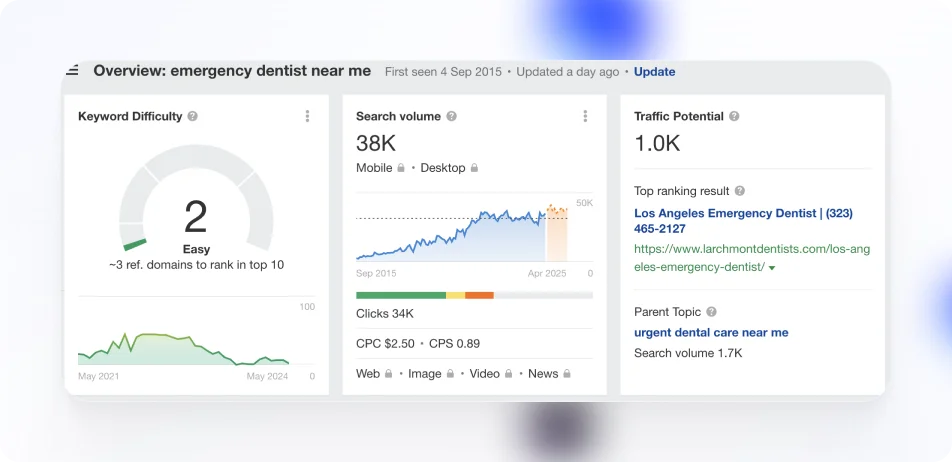
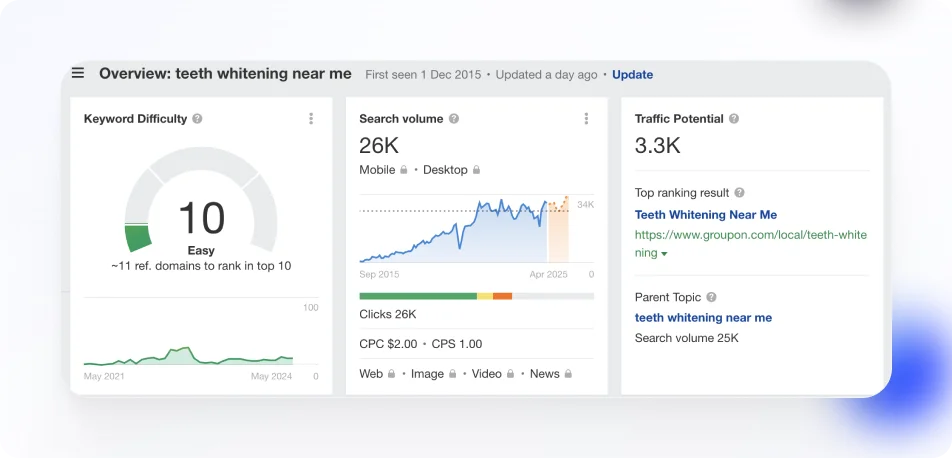
For the keyword "Emergency Dentist Near Me," the difficulty rating is 2, which is categorized as easy. This implies that approximately 3 referring domains are typically needed to land in the top 10 search results. The search volume for this keyword is quite high at 38,000 per month, with actual user clicks at 34,000, indicating a high level of engagement and interest from potential patients. The traffic potential for ranking number one for this particular keyword is about 1,000 visitors per month.
The keyword "Teeth Whitening Near Me" shows a slightly higher difficulty of 10, yet still falls within the easy category. Here, about 11 referring domains may be needed to achieve a top 10 ranking. This keyword also enjoys a robust search volume of 26,000 per month and matches it with an equal number of clicks, showing that nearly every search results in a click. The traffic potential stands at 3,300, suggesting this keyword can draw a significantly higher number of visitors, potentially because of the popular interest in cosmetic dental services.
Ranking for either of these keywords seems fairly accessible given their low difficulty scores, which is advantageous for dental clinics looking to enhance their online visibility. Typically, ranking between positions 1 to 3 can garner the most significant share of traffic, progressively decreasing as the rank lowers.
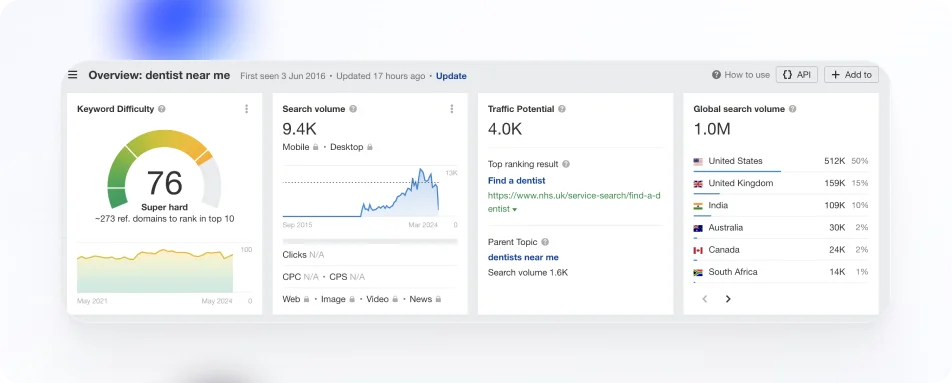
The keyword "dentist near me" presents a challenging scenario for SEO efforts within the dental industry. It has a very high difficulty, yet when compared with its search volume and traffic potential, it reveals a less promising opportunity for investment. With a traffic potential of only 4,000 visitors despite substantial effort required to rank, it illustrates a critical aspect of SEO: not all intuitively beneficial keywords are actually profitable or viable.
This scenario underscores the importance of a thorough understanding of SEO dynamics. Proper keyword analysis and selection are pivotal, as investing heavily in highly competitive keywords may not always yield proportionate returns. Therefore, strategic keyword selection, aligned with realistic SEO goals, is essential in optimizing both effort and resources in digital marketing campaigns.
This analysis highlights just a snapshot of potential keywords in the dental SEO landscape. A robust SEO strategy would incorporate a broader spectrum of keywords tailored to various pertinent services and location-based terms to maximize online visibility and attract more patients. Effective SEO involves a mix of optimizing onsite content, building quality backlinks, enhancing local SEO efforts, and continuously analyzing performance and competitors.
For dental clinics looking to optimize their websites strategically, obtaining professional SEO services can yield significant benefits. Utilizing the expertise of our SEO agency can help you in crafting tailored strategies, ensuring sustained business growth.
On-page SEO
On-page SEO refers to the strategies applied directly within your website to help improve position in the search rankings. Here are key elements of on-page SEO:
- Keywords. As mentioned above, keywords are always important, especially for on-page SEO.
- Quality Content. Publish high-quality, informative content that addresses common questions and concerns of patients. Blog posts, FAQs, and service explanation pages can all add value.
- Meta Tags. Ensure that title tags, headers and meta descriptions are succinctly written, incorporate main keywords, and are designed to encourage click-throughs from search engine results pages.
- Images and Videos. Optimize all visual media with appropriate image names and alt text descriptions that include relevant SEO keywords. This enhances their discoverability in image search results.
- Internal Linking. Use internal links to connect the content within your website, which helps with site navigation and spreads link equity across pages.
- Mobile-Friendly Design. Since more users are searching on phones, ensuring your website is accessible and mobile-responsive is crucial for both user experience and SEO.
- Speed Optimization. Enhance website loading times as faster websites provide a better user experience and are favored by search engines. Nearly 45% of users will abandon a website if it takes more than 3 seconds to load.
- SSL Certificate. Secure your website with HTTPS encryption. Google considers site security as a ranking factor.
Schema markup is another powerful tool within on-page SEO for dentists that helps search engines better understand the content of your website. For dental practices, implementing schema markup can enhance the way your pages are displayed in search results through rich snippets, which may include reviews, ratings, and business hours.
To improve your use of schema markup, ensure you incorporate specific schemas such as the LocalBusiness schema, Person schema for dentists, and the schema for medical procedures offered. By detailing your services, location, and practitioner information through schema, you can make your dental practice more visible and appealing in search results, potentially attracting more patients. Schema.org can help you, providing detailed lists of schema properties for dentists.
Schema.org offers comprehensive lists of schema properties that are specifically beneficial for dentists, providing a valuable resource for enhancing your website's structured data and improving SEO.
Check out our SEO checklist to ensure you remember the basic yet important elements of improving your dental SEO!
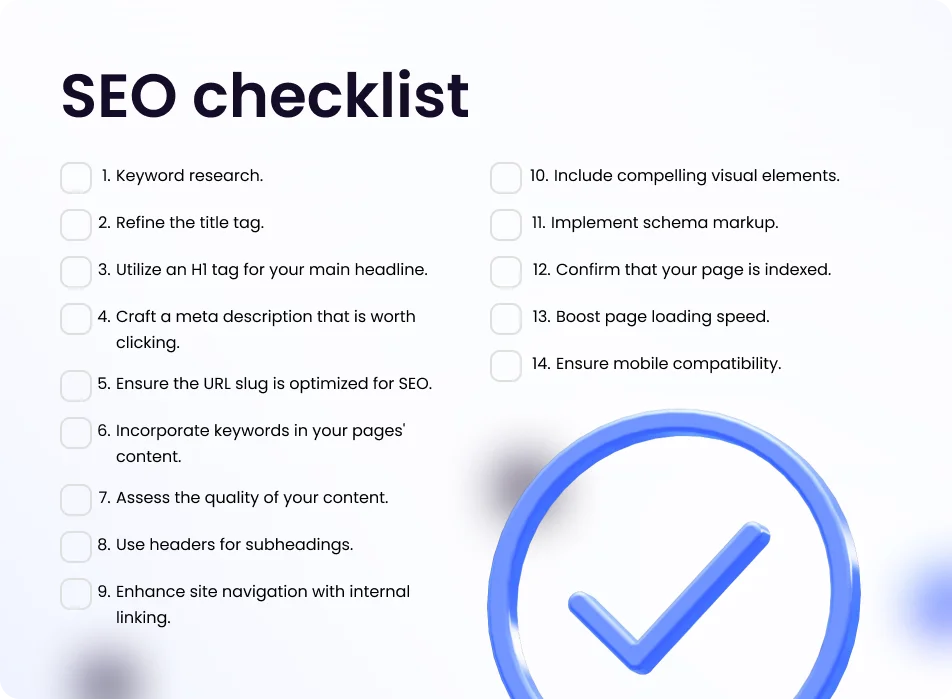
Off-Page SEO
Off-page SEO involves external optimization practices that occur away from your website. These are mainly focused on building the site’s reputation and authority.
- Backlink Building. Strive to gain high-quality backlinks from reputable sites within the dental or health care industry. This can significantly elevate your site’s authority and credibility. Backlinks are very imprtant in SEO. We will explain how to build them.
- Local Listings. Claim and optimize listings on local directories and business aggregations sites, particularly those related to healthcare and local businesses.
- Google My Business. As mentioned, optimizing your Google My Business profile is essential for local SEO, helping you appear in local search results and Google Maps.
- Social Media Engagement. Develop a strong social media presence on Facebook and other platforms. Regular posting and interaction on different social media can drive traffic to your website and help with SEO.
- Encourage satisfied patients to leave positive reviews on your Google My Business profile and other review sites. Respond to reviews to show that you value patient feedback.
Backlinks
Backlinks deserve a separate mention. Ranking factors for backlinks encompass several crucial elements that determine the quality and effectiveness of these links in enhancing your website’s SEO. These factors include:
- How the Link Was Earned. The method by which the link was acquired plays a significant role, whether it was earned naturally through the merit of content, manually through outreach efforts, or self-created through directory submissions or forums.
- The Linking Site’s Popularity. The level of traffic and visibility of the site that links to yours affects the power of the backlink. Links from more popular and frequently visited sites are generally more influential.
- Relevance of the Linking Site’s Topic. The subject matter of the linking site and its relevance to your own site’s content is crucial. A link from a site that shares closely related topics carries more weight, as it is seen as more contextually relevant.
- Recency of the Link. Newer links can be more beneficial as they reflect the most current state of your website’s content and partnerships.
- Trustworthiness and Authority of the Linking Site. Links from authoritative and trustworthy sites, often measured by metrics like Domain Authority (DA), significantly boost your site’s credibility and SEO performance. Ensure compliance with Google's link spam guidelines because creating harmful backlinks can detrimentally impact your SEO endeavors.
- The Number of Links. The quantity of links pointing to your site also matters, though the quality of these links is usually more important. A higher number of high-quality backlinks can significantly enhance your site’s search engine ranking.
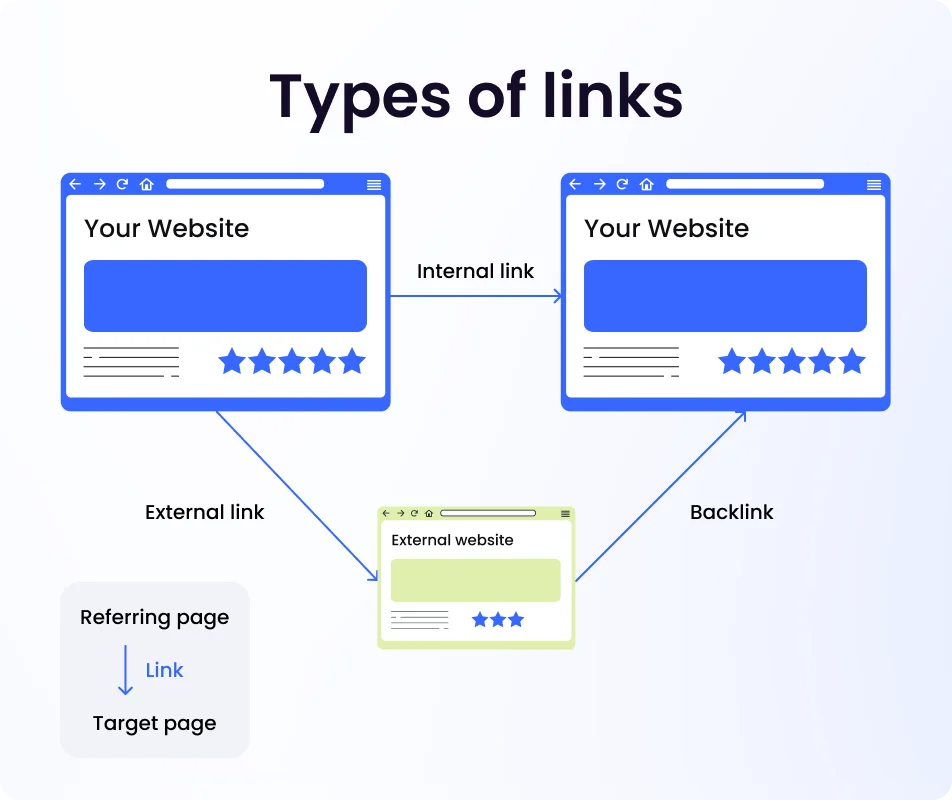
User Experience
User experience (UX) plays a pivotal role in SEO for dental offices, as it directly affects how potential patients interact with your website. A positive user experience not only helps retain the site visitors but also contributes to higher conversion rates and encourages engagement, which are crucial signals for search engine rankings. Here are key components that enhance UX on a dental website:
- User-Friendly Design. Ensure that your website's design is intuitive and user-friendly. A clean, aesthetically pleasing layout with cohesive branding helps establish professionalism and trust. The design should cater to all users, including those with disabilities, by adhering to accessibility standards.
- Clear Navigation. A well-structured menu with clearly labeled pages is crucial to help visitors find the information they need quickly. This includes having distinct pages for different services like general dentistry, cosmetic procedures, orthodontics, etc., which allow for more detailed and specific content.
- Fast Loading Speed. Website speed is critical for a good user experience. Slow loading times can lead to high bounce rates and lost potential clients. Optimize images, streamline code, and reduce redirects to ensure your website loads quickly.
- Mobile Optimization. With increasing numbers of users accessing the internet via smartphones, your website must perform seamlessly on mobile devices. Responsive design ensures your site looks and functions well regardless of the device used.
- Online Booking System. Implement an easy-to-use online appointment booking system. Many patients appreciate the convenience of scheduling their visits online without the need to call your office. Make sure the booking interface is simple and straightforward.
- Interactive Elements. Utilize interactive elements like chatbots for instant communication, virtual tours of the clinic, or video testimonials from satisfied patients. These elements can significantly enhance the user engagement and provide additional value.
- Clear Calls-to-Action (CTAs). Use compelling CTAs that guide users on what to do next, whether it's booking an appointment, signing up for a newsletter, or contacting your office for more information. Well-placed and clear CTAs can increase conversion rates and improve the overall user experience.
Experience, Expertise, Authoritativeness, and Trustworthiness
To successfully convey this expertise through your dental website SEO, consider the following tips:
- Detail Dentist Qualifications. Provide comprehensive information about the qualifications and experience of the dentists at your practice. This transparency helps patients feel more confident in their choice of provider. You can also provide bio of the dentists.
- Highlight Accreditations. Prominently display your practice's credentials, such as board certifications. This not only builds trust but also confirms your professional authority to prospective patients.
- Ensure Credible Information. Make certain all the information provided on your site is reviewed by professionals and sourced credibly. Accurate, reliable content is key to maintaining the trust and safety of your patients.
This way, patients are more likely to trust their health to you.
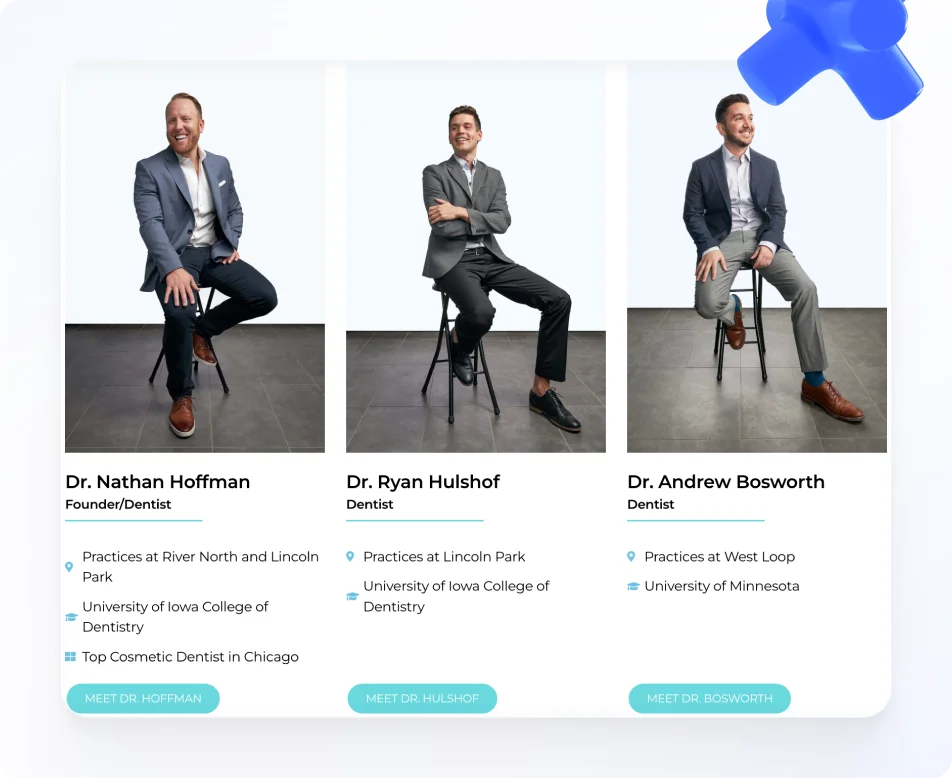
Voice Search
This feature is rapidly growing in popularity, transforming how people interact with their digital devices. According to a study by PwC, 71% of respondents prefer using voice search over typing their queries, emphasizing the shift towards voice-enabled technology. The convenience and efficiency of voice assistants like Amazon's Alexa, Google Assistant, and Apple's Siri are key drivers of this trend.
As voice search becomes more prevalent, optimizing your website for voice queries is essential, especially for businesses like dental practices where local search relevance is crucial. This is also a part of dental SEO. Here are a few strategies to optimize for voice search:
- Focus on Natural Language and Conversational Keywords. Since voice searches are typically more conversational than typed queries, incorporate long-tail keywords that have more natural speech patterns.
- Optimize for Local Search. Many voice searches are looking for local information. Ensure that your practice's name, address, and phone number are consistently listed across your website and on online business directories.
- Create FAQ Pages. Create good FAQ pages that clearly answer common questions patients might ask about dental health and services. Use clear, concise responses that voice search devices can easily interpret and relay.
- Improve Page Loading Speed. Voice search devices often pull answers from fast-loading pages. Ensuring your website loads quickly can increase the chances of your content being featured in voice search results.
Content
Now that we've covered the foundational aspects of SEO for dental practices, let's turn our attention to a critical component: content. Content is paramount in dental search engine optimization, as it not only helps to inform and educate potential patients, but also significantly boosts your website's visibility and rankings. The most common way to share content is blogging.
For dentists and clinics looking to leverage blogging as part of their SEO strategy, creating engaging, informative, and patient-centric content is key.
Write about issues that are directly relevant to your patients. This could include preventive dental care tips, explanations of common dental procedures, advice on oral health care for children, or discussions about the latest advancements in dental technology. Understanding the concerns and interests of your target audience can guide your topic selection. Don’t forget to optimize your blog posts with relevant SEO keywords without overstuffing.
Patients often turn to dental blogs for answers to specific health questions, so providing clear, well-researched, and informative content is crucial. Cover topics like the importance of regular dental check-ups, how to deal with dental emergencies, or the benefits of orthodontic treatments.
To make your blogs interesting, you can use these tips:
- User-Friendly Language. While it’s important to showcase your expertise, keep the language simple and jargon-free to ensure it's accessible to all readers. Use layman’s terms and explain dental terms when they are used.
- Engaging and Interactive Content. Make your blog posts engaging by incorporating relevant images, infographics, and videos that can help explain complex procedures and concepts more clearly. Interactive content such as quizzes or polls about dental health can also increase engagement.
- Regular Updates. Consistency is key in blogging. Regularly updating your blog with new content can help keep patients informed and engaged, while also signaling to search engines that your website is active, which can boost your SEO.
- Patient Stories and Testimonials. With proper permissions, share success stories and testimonials from your patients. This not only adds a personal touch to your blog but also builds trust with prospective patients.
- Call to Action (CTA). End each post with a strong call-to-action encouraging readers to book an appointment, subscribe to your blog, or follow you on social media for more useful information.
Take the Best from Competitors
Analyzing your competitors is a strategic approach that can significantly enhance your SEO efforts. By examining what successful competitors are doing, from their keyword utilization to the types of blog content they publish, you can gather valuable insights into what appeals to your shared audience. This can help improve your SEO.
Take the time to study their best-performing posts, the frequency of their content updates, their use of multimedia, and how they engage with their audience. Once you have these insights, you can refine these ideas, tailor them to suit your unique brand voice and audience and integrate them into your dental marketing SEO strategy. This method isn't just about imitation, but about learning what works in your industry and applying these lessons in innovative ways to outperform your competition and better serve your patients.
Measure Important Metrics
Measuring your SEO metrics is crucial to understand how well your online marketing efforts are performing. Before diving into SEO, it's important to establish a baseline of your current online presence.
Start by tracking the amount of traffic your website receives, where it comes from, and your site's ranking for key search terms related to dental services in your area. Use tools like Google Analytics to monitor website traffic and Google Search Console to view your search rankings and see which queries bring users to your site.
Regularly checking these metrics will give you an insight into what's working and what might need adjustment in your SEO strategy. This initial assessment will help guide your SEO objectives and measure progress effectively.
Conclusion
SEO for dentists can unquestionably be a complex and challenging endeavor, yet it is immensely rewarding. It demands attention across multiple dimensions, from optimizing website content to refining technical SEO features and developing robust local search strategies.
Given the sophisticated nature of SEO and its critical importance in attracting new patients, seeking professional assistance may be beneficial. If you find yourself needing help to create and implement an effective SEO strategy, our agency is here to support you. We specialize in comprehensive SEO solutions tailored specifically for dental practices, ensuring you can focus more on your patients while we grow and enhance your online presence.
Faq
How long does it take for search engine optimization for dentists to work?
The timeline for seeing results from SEO can vary depending on several factors including the competitiveness in your location, the current state of your website, and the strategies implemented. Generally, it can take around six months to begin seeing significant changes in search engine rankings and website traffic, leads. SEO is a long-term investment; it requires ongoing effort and adjustments based on algorithm updates and market dynamics to achieve and maintain optimal results. Patience and consistency are key in allowing SEO strategies to fully manifest their potential impact.
Do dentists and clinics really need a website and SEO strategy?
Absolutely, having a website and a SEO strategy is crucial for dentists and clinics in today’s digital age. A dental website serves as the primary online presence where potential patients can learn about the services offered, the qualifications and experience of the dental team, and read patient testimonials. It also provides a platform for patients to easily contact the clinic, schedule appointments, and find practical information such as business hours and location. Moreover, a well-optimized website can help attract new patients by improving visibility and reach through search engines.
How do I understand that SEO for dental website works?
To understand if SEO for your dental website is working, monitor key performance indicators such as increased website traffic, higher search engine rankings for target keywords, and an uptick in patient inquiries or appointments originating from your website. Regularly reviewing these metrics will give you a clear picture of the effectiveness of your SEO efforts.






